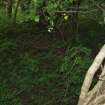South Nitshill, Corselet Wood, Darnley
Anti Aircraft Battery (20th Century)
Site Name South Nitshill, Corselet Wood, Darnley
Classification Anti Aircraft Battery (20th Century)
Alternative Name(s) Gsg4; S4; Clyde Aa Defences; Nitshill; Darnley
Canmore ID 107530
Site Number NS55NW 55
NGR NS 5250 5944
NGR Description Centred 5250 5944
Datum OSGB36 - NGR
Permalink http://canmore.org.uk/site/107530
- Council Glasgow, City Of
- Parish Eastwood (City Of Glasgow)
- Former Region Strathclyde
- Former District City Of Glasgow
- Former County Lanarkshire
NS55NW 55 Centred 5250 5944
Nothing survives of this anti-aircraft battery which was situated to the N of Corselet Road, South Nitshill.
Information from J Guy, September 1996
The heavy anti-aircraft battery consisted of four gun-emplacements and a command position with the GL mat (gun laying radar false horizon hexagon) to the W. The accommodation camp was situated on the other side of Corselet Road.
Information from RCAHMS (DE) July 1997
This World War II heavy anti-aircraft battery was situated on the N side of Corselet Road. Nothing survives on the site on which modern housing has been built.
The battery was armed with four 3.7-inch guns.
J Guy 2001; NMRS MS 810/11, Part 3, 209-10
The WW II heavy anti-aircraft battery is visible on vertical air photographs taken in 1946 (106G/Scot/UK 140, Pt III, 5247-5248, flown 3 July 1946). The photographs show that the battery was provided with six gun emplacements, an arc of four of one type and two additional to the NW and SE of the arc. Public Record Office documents show that the battery was originally armed with four x 3.7-inch guns during 1942 and a GL radar set, but by November 1943 six had been supplied and the Gl-Mk 1A radar removed (PRO AIR 2/4768; WO 166/11169).
The air photographs also show that the accommodation camp lay in a field between Corselet Road and the Aurs Burn. A total of at least 42 huts are visible, most of the Nissen type. within the dogleg taken by the road.
Information from RCAHMS (DE), September 2005
Field Visit (21 June 2017)
This was one of at least 43 Heavy Anti-Aircraft batteries that were constructed to protect the industries in the centre of Glasgow and along the banks of the River Clyde from aerial attack by the Luftwaffe during WWII. However, only a fragment of the camp associated with it survives and this is a single, heavily overgrown, concrete platform (NS 52587 59261) situated in waste woodland between Corselet Road and the Aurs Burn. It is rectangular on plan and measures at least 6.5m from NW to SE by 3.5m transversely and 0.2m high. Much brick and rubble debris is scattered hereabouts over what is now very largely disturbed ground.
Visited by HES, Survey and Recording (ATW, AGCH) 21 June 2017








